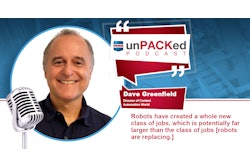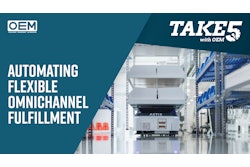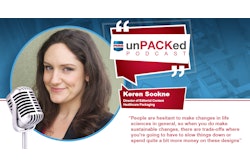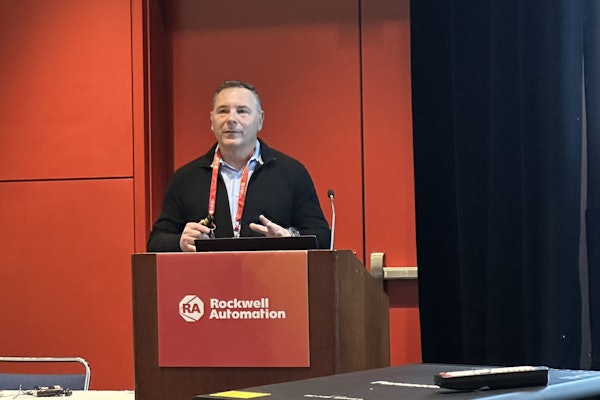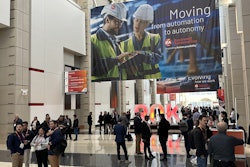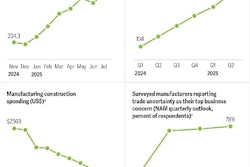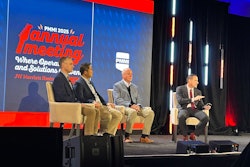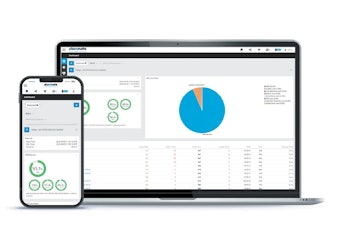With one of the most successful PACK EXPO Las Vegas and Healthcare Packaging EXPO’s ever firmly in our rearview mirror, unPACKed with PMMI turns its attention to the best regional packaging and processing show in North America: PACK EXPO East 2022, March 21-23 at the Pennsylvania Convention Center. For three days, over 7,000 attendees from the rich Northeast corridor of CPGs and Pharmaceutical companies drive, train and fly into Philadelphia for an environment that promotes one-on-one time between over 400 exhibitors. For an idea of some of the best in class technology and education available at PACK EXPO East, we discuss some of the top trends and technologies our PMMI Media Group editors have come to expect from events in the PACK EXPO portfolio of trade shows.
To subscribe, rate, review and find more unPACKED podcast episodes, visit pmmi.org/podcast or find us on Apple podcasts, Spotify or iHeart Radio.
 | Read the full transcript below. |
Sean:
Aaron, we talked a little bit before and you were telling me how you were able to catch a little bit of the Cold Pressure Council Conference, get some of the education from there, that you can use later in a story. Anything you picked up over there that you might want to share with the audience?
Aaron:
Sure. So yeah, just for a little while I managed to head up, upstairs in the North Fall, go to the Cold Pressure Council. So the session that I sat in on was actually talking about the possibility of using High-Pressure Processing for plant-based protein. So spoiler alert, they're not really yet, but he was looking more at kind of the science behind. When you use High Pressure Processing for actual meat, you get beef that was red that now looks white by the time it gets enough pressure on it to actually kill the germs. With plant-based proteins, it actually works better. So you don't have the degradation because it's not a complex material to begin with. That was actually pretty interesting and just thinking of about the concept of combining HPP with plant-based proteins but also just separately, then back on the Show Floor, there's a lot of conversations that I'm having with people about High Pressure Processing and also about plant-based proteins separate.
Aaron:
So it's been kind of interesting, I was over at the GEA booth and their showing systems that they've been using for other foods that are now being used for plant-based proteins. So they're centrifugal to cancer, for example, they're using a separate out, proteins from soy, for example, or also their power grind which would normally be used to grind up beef, ground beef is being used to grind up plant based proteins. So it's a whole different process, but they can use the same machines. So, and then separately High Pressure Processing, had a pretty interesting discussion today with a JBT of Viewer, which has just come out with a new HPP system where they can run things, not just in individually packaged bottles, for example, but also in bulk, and they can do it on the same line.
Aaron:
So they'll have two baskets and this basket could be full of two ounce shots, or one and a half liter bottles or whatever they can pack in there. And the next basket might have a bag that is filled in bulk, and that lets them fill it up to like 95% pack efficiency, as opposed to those bottles, where you're going to have a lot of wasted space in between there, but it gives the flexibility to pack those better. But also later to be able to put those as products into say a glass bottle, which you can't do HPP on a glass bottle, or a carton or on aluminum. So it gives them much more flexibility in what they can do with that packaging.
Sean:
And that's interesting because it is something, I've will admit I've thought about is how the influx of plant-based proteins and how Burger King has them now. I mean, everybody has plant-based proteins, but how that has affected from a food processing standpoint. So it sounds like what you're saying is they have ways to adapt it where you can use the same machinery. Obviously they're going to clean it all out and stuff like that, but the same machinery can be applied to plant-based protein as it can to regular proteins-
Aaron:
Yes.
Sean:
... Is that safe to say?
Aaron:
Yes.
Sean:
Well, if there's one person that knows how to talk about flexibility, it's our Matt Reynolds. I mean, this guy covers flexibility in packaging like [crosstalk 00:03:29] it's nobody's business-
Matt Reynolds:
I'm a gymnast.
Sean:
... What's that?
Matt Reynolds:
I'm a gymnast.
Sean:
Like a gymnast, yeah. Much better segue than I had. What have you seen out there on the floor Matt?
Matt Reynolds:
Well, speaking of flexibility, one of systems within machines that historically has been less flexible, would be like material handling or any kind of track systems that are mechanical. So mechanical means the speed it's going on one side of the track, it's going on the other side of the track because they're linked. But within the last, I would say six, eight years, we've seen these linear servo track systems that instead of each mover on a track being linked, or these movers are then individual and they're capable of moving themselves via electromagnetic forces. And there are three big ones. There's the iTrack from Rockwell, there's XTS from Beckhoff, and ACOPOS track from B&R. So those are the three, and it's interesting because we've had a long interval since the last show due to the pandemic-
Sean:
Right.
Matt Reynolds:
... So what had been a slow, kind of gradual evolution really seems to have taken a step forward at this show and these track systems were almost exclusively, I could find them, but they would almost exclusively be in those controls booths. They'd be at the Beckhoff booth or they'd be at the B&R booth. Well at this show, what struck me is I'm seeing them on the Show floor in the OEM's booths, so they're actually incorporated into the machines. There's a couple of good examples of these, the most obvious one was there's a joint between Pharmaworks, it's a ProMach company. Pharmaworks in Serpa, as the handshake between those two machines as they're integrated is a Beckhoff XTS system, linear transport also in the ProMach booth is Bartelt. They basically invented the Horizontal Form Fill Seal systems like 40 years ago.
Sean:
Yep.

And they're using these track systems. They're using the iTrack from Rockwell to great effect, and today I saw a wash down track system from the XTS also from Beckhoff. So two different varieties there from Bartelt, it struck me that there was a Schubert machine, a light-line Schubert machine, that the person wasn't even sure which track system it was. It was in there and it was their light-line model, and the light-line model means that this was kind of their 90% off the shelf version, their lower end model. So even in Schubert's lower end models is this forgettable track system, in this case, it was for real application, I think a Yasso ice cream bars, anyways it was a real application and it was almost forgettable that these track systems are already incorporated in the machinery themselves. So it's funny to watch that evolution go down from the controls, and then the next step on that is these planter systems, which currently are only in the controls booths. But I would expect maybe by Chicago, we'll start to see a few in actual OEM applications.
Sean:
That's interesting because we had this yesterday, the Daily Download when we were talking about how robotics this is, we've seen this over robotics where it's been a slow evolution. And then again because we had this gap of 18 months of not having a show, it seems like here, everywhere you go now you're seeing automation and robotics that can be applied in almost every application versus it being kind of tucked away in the corner. So that's another great example of something that you didn't expect to see kind of ramp up overnight, but overnight was 18 months-
Matt Reynolds:
20 months.
Sean:
... Yeah exactly. That does tie in, I think with something that Stephanie and I were talking about before, as well with the, I guess, an intelligent devices.
Stephanie:
Yeah well, as OEM's are adopting more technology, as Matt's saying, we're seeing these systems at the OEM and they're building machines around them. What I'm seeing now is engineering made easy. So like the drive companies, the motion control companies, like Linza is doing more intelligent drives. They're putting preset technology applications in there for positioning and speed, so that the engineer doesn't have to do that. It will just automatically, you can get some software downloaded for free and it automatically sets the set point so that you don't have to do all that programming. And then as part of that, there's also auto tuning with the drive and the machine. So typically it's an experienced engineer who has to sit there for hours and listen and they know, what it sounds like when the machine is working correctly, or when it's not, but they're using their own sensories to figure out if it's working or not.
Stephanie:
Well now, Linza has put some auto tuning in there, so there's some algorithms that are automatically adjusting the drive with the machine. So that, it's tuning itself. I also saw an example over at Yaskawa at the Robotic Palletizer. They're working with a company called Mojen Corporation and they have some 3D scanning technology or 3D imaging technology. So typically I think when we're palletizing, we're using the same dimension of box and putting it, and it's a pattern, but with the influx of E-Commerce buying, there's all these different size boxes now, and there's also different volumes. So this is automatically in real time adjusting the palletizer to pick up different size boxes and put it into different formations, and patterns. So again, it's just another example of adding intelligence into the devices, into the drives, into the robots, to make sure that it's easily executed, and takes a lot of the burden off of the engineer.
Sean:
And, this is another theme that we've seen throughout the show. There was always this perception that robotics and automation are coming to take jobs, or coming to replace humans. And you just gave again, perfect examples where it's not replacing them, it's making, a) Their job easier and allowing, I'm pretty sure an engineer would be better served doing some engineering versus listening to hours of a thing to hear and pick up sounds. So this is just another example, and then the same with the palletizing where normally you would have a person having to do that. You've taken that, I guess what they call the triple D dirty, dark and dangerous?
Stephanie:
Dangerous.
Sean:
There it is, taking those three out of the way and having a robot do it. You're not getting rid of an employee, you're moving them up to something which can better apply their skills.
Stephanie:
Yes.
Sean:
And that really ties into because again, and I think you can speak to this a little bit more, we're dealing with a workforce, we're at the crisis level,
Stephanie:
Yep.
Sean:
And we need these things to also bring in younger generations who are used to working with iPhones and iPads, and things like that because this kind of technology isn't too far advanced for them. So what other workforce type things have you seen out there?
Stephanie:
So over at the Beldon booth, there's a student over there, a high school student from Glenbrook South High School in Glenview, Illinois. And over the summer, there was a team of students working with the folks at Beldon and some robotics, some technology from of Emerson, some conveyor technology, some HMI, some sensors, some vision. And, they're trying to educate the younger, this high school and even younger on not just the robotics competitions that we see, that you generally, you'd see them doing a fun little application. We want like some real world type applications. Now granted, what they're doing is laminating a business card and I have one in my pocket, but the student is actually using technology that they've never used before. So the vision system, the database, the robotics of course, the sensors, and the motion control, and the industrial networking.
Stephanie:
And, he's saying he could never ever in the high school engineering class, get this education, but talking to the folks at Beldon, Chris Noble who's the global director over there. He is trying to teach them more about critical thinking and deadlines, and figuring out, all right, this is going wrong. How do I correct it?
Sean:
Right.
Stephanie:
Right, not push through the exact same application, but what do I do differently to make this work? Because you know, on the manufacturing floor, things go wrong all the time. So you have to have that critical thinking of how this will work. So I also want to point out that this program was put in place with the help of PMMIU skills- [crosstalk 00:11:31]
Sean:
Oh, very cool, that's fantastic. And again, it just seems to be a thing that keeps coming up, that we're getting away from thinking of manufacturing, and the factory floor as this black and white picture from the fifties where everything's gray, and it's greasy and so, it's high tech and things that, again, a kid in high school who already knows how to do a lot of this stuff can apply right now. And that's what we like to see because we need people to be working in this workforce for years to come.
Stephanie:
Yes.
Sean:
I've not forgot about you, Karen. I apologize. What have you seen out there that you would like to share with the folks?
Karen:
Well, one thing, I didn't get a chance on Monday in the Daily Download to talk anything about COVID-19 and obviously in the Healthcare Packaging Expo, so much of the machinery there has been supporting those efforts for the last 16 or 12 months. So there's something cool that I wanted to talk about, which is a new pierceable foil lidding for diagnostics, and this is AccuPierce from PAXXUS. Obviously COVID is an absolute tragedy, one of the by-products of it is just the boom in diagnostics needs. So this is not just a matter of the sheer volume of people that need diagnostics but at this point we've seen a shift in consumer expectations that, now they see that they can get diagnostics. They're used to having to go to the clinic and do everything at the doctors. And, sometimes wait weeks and wait a long time, and now people have become accustomed to getting results in an hour, sometimes 15 minutes, these rapid tests.
Karen:
And, once you let that out of the bag for a consumer, they don't move backwards, they don't wait longer. And, so there are hundreds of companies now who are trying to develop diagnostics, not just for COVID-19, but for a range of disease states. And so what that means is that we're needing a lot of innovation and diagnostics, and so something that's cool about AccuPierce is basically, it allows for a clean quick puncture in these very sensitive testing environments. So it's usually a probe that's going in and that needs to be fast, repeatable, but the struggle there is that while it needs to be puncturable easily, packaging has to withstand these really strong reagents. In some cases they can interact with foil lidding, sometimes they can really actually attack the lidding. And so they really have to be this very sturdy yet pierceable material.
Karen:
So if you're not familiar in these diagnostics, three agents are sitting in lids and you can kind of liken it to the way that an ice cube maker looks, it's these little wells and, it's shrunken down and then the foil sits on top of that. And so you're having these very narrow ceiling areas. They're very small and so it's just a lot of factors at once competing. So the lidding consists of this really controlled aluminum foil that is paired with PAXXUS's chemically resistant, high barrier exponent sealant. And so they made it in a way that it's flexible, so it's heat sealable to a variety of common reagent material. So that's polypropylene, polyethylene and COC. And so I think that's just a really important area that sometimes people overlook, is-
Sean:
absolutely.
Karen:
... is this innovation to really push diagnostics forward, because think of all the things that we couldn't do in our society if we didn't have those answers in front of us, so much commerce, so much travel, so much everything would be stopped, without knowing, are you positive for this, disease state or are you not? So I thought that was a really interesting one.
Sean:
I mean it's fascinating, it's amazing. And it's something that, as you're saying it, like you're thinking of things in your head that that could be applied to for other-
Karen:
Right.
Sean:
... Whether it's a lower level sickness, a cold or the flu or something like that, where you don't go to a doctor or don't have to go get the test because you can take it yourself and that test, it would be a really unique and, and kind of cool application to come out of this very in, did I miss anybody feel like I have everything?
Matt Reynolds:
No, I would like to just say something. This is about the automation in general, and you mentioned workforce, just a thirst for automation. That's on the Show Floor right now, it's unlike what I've seen previously. And one very high level OEM, let's say multiple OEM's have said that the conversation used to be, for any level of automation, particularly the latest automation, these track systems, these planter systems is what's the ROI? What's the payout? What's, how long is this going to take to pay itself off?
Sean:
Absolutely.
Matt Reynolds:
That conversation's not happening anymore. Conversation is how soon can I get it? And can I be the first person in line to get it? And here's a PO right here in the booth.
Sean:
Right.
Matt Reynolds:
You know we've seen that happen in this week, or these last few days where people are trying to get ahead of their competitors,
Sean:
Yep.
Matt Reynolds:
For a limited supply, because we know lead times are a big problem right now. So it's, whether it's just getting the machine up and running or getting the machine into the building, whatever these end users can do to, to bend over backwards and to get that machine up and running, going, they're not worrying about really the ROI at this point and that's needed.
Sean:
And that's like you said, it's always was the number one thing was when's the return on investment, to invest in this robotics or automation. And it seems to me to have been one of the biggest hold ups all this time, and I think we've seen over the past 18 months that you've had to incorporate it, like you said, or you're going to fall behind. And now they're realizing as everyone has just been trying to keep pace, essential businesses, everyone had to stay open, that going forward you're going to need the latest and greatest, or like you said, it's not a competitive advantage anymore and you're falling behind.
Aaron:
Well, it is. It's right back to the workforce issues. I mean, people are just, I'm hearing so much of that this week. They're just clamoring for people that they cannot get. So they have no choice, but to automate. And the flip side of that too is, they're clamoring about supply chain issues. You've got both of those put to together and everybody's going to be grabbing [crosstalk 00:17:15] .
Stephanie:
I think they, just to jump in, I think the OEM's too are being really flexible on how they're bringing their machines to market, or I know like Robex, just recently now making their machines available, they're leasing them. I know it's not that new of a concept, but it's more about, let's get the machine in there quickly and then we'll follow up with our services.
Sean:
Yep.
Stephanie:
So, the technology itself is, it's not always the differentiator. I think we're moving more into this service orientated type- [crosstalk 00:17:44]
Sean:
Kind of seen as a service, I think is what it is?
Stephanie:
... Yeah.
Karen:
Yeah, I'm definitely seeing a little bit more focus in the booth in terms of like being able to help with integration, not the component, the in feed and the out feed of two different machines don't work right. So there's a lot more focus on helping out with that. It's kind of a [baseless 00:20:57] Service.
Sean:
Making it more, and it's more of a relationship versus I'm buying a piece of equipment, then see [crosstalk 00:18:06] you in 30 years if something happens to it.
Karen:
Right.
Aaron:
Absolutely.
Karen:
But I do have something on the flip side of that, which is that there's a lot of new life science technology at the show that is bridging some really necessary gaps for the small and mid-size production companies. So, we do tend to see the bells and whistles, and the really high speed machinery. But at the same time, I don't think we realize necessarily how much companies rely on these smaller and midsize, sometimes little Table top, Bench top systems, especially in life sciences. So I just kind of wanted to note that I saw the groaning or lab work series, which is Table top liquid filling and stoppering and ceiling systems. And this is for R&D personalized medicines, bio syringes, and another, a place where this really comes into play is Compounding pharmacies. And so these are really important pieces of machinery.
Karen:
Something cool with that is that the controls are web based, so while the machines are manually operated, it requires fewer people in these kind of clean room type areas. So that's really a help, and also Anteres has a Mini Manual Aggregation Station. We didn't really get too much into traceability, but if you check my site, it's full of traceability information, we are hurdling towards 2023 deadlines for serialization requirements. And so Antares created this Mini Manual Aggregation Station. It is, if you happen to see it at the booth, I mean it is not much larger than this laptop, certainly taller, but you know, the footprint is very small, and that's going to help companies who are smaller and mid-size outputs basically get compliant with aggregation.
Karen:
It also supports something that we kind of overlook sometimes, which is warehouse and distribution center rework. And so you're able to kind of implement these really small compact systems in a distribution center, and basically make sure that product is flowing through our supply chain. There's actually a lot of rework that takes place and if you're not doing it in a timely manner, it can cause drug shortages because you need to make sure that product is flowing smoothly, and not getting quarantined, and not getting held up. And so, I do kind of want to also highlight these sort of smaller Bench top machines that are putting in a lot of work.
Sean:
Absolutely, and I feel like a lot of times we get a lot of the innovation, from these smaller companies that are kind of adjusting on the fly and figuring out how to make things work. And from that you get these innovations that then, the bigger companies swoop in and want to kind of mimic. So that's great, and I'm glad that you to add that in. So I guess with that in mind, these are just some of the many innovations that you can see at Pack Expo, Las Vegas and Healthcare Packaging Expo. I would also like to highlight that going forward, we're going to have Pack Expo East, that's March 21st through to the 23rd in Philadelphia. So I just, one more time, we'd like to thank Aaron, Karen, Matt, and Stephanie for taking some time to come off to Show Floor, share this with the peop

